De Morgan’s Laws

Up to this point, we’ve done some introductory work with Venn diagrams, set theory, unions, and intersections. How do we handle more complex set theory expressions, like the complement of a union or the complement of an intersection?
\((A\cap B)’\)
De Morgan’s laws are helpful tools for representing complex expressions like these in more understandable ways.
To understand De Morgan’s laws, let’s temporarily replace the complement sign with the word “not.” Starting with the complement of \(A\cap B\), we get:
Using a Venn diagram, we can see this as everything except the intersection of \(A\) and \(B\).
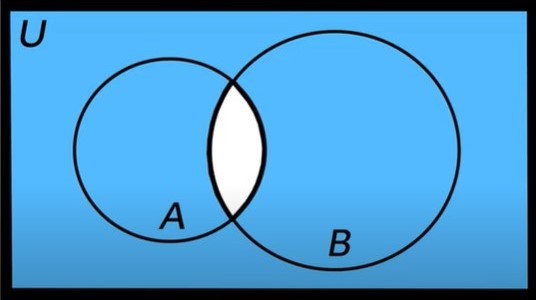
One of De Morgan’s law says that we can distribute this “not” to the sets inside the parentheses \(IF\) we switch that intersection to a union. So “not \((A\cap B)\)” becomes “not \(A\) union not \(B\).”
Let’s graph the complements of \(A\) and \(B\) to verify that their union is the same as the complement of \((A\cap B)\).

The only thing not covered by \(A’\) or by \(B’\) is the intersection of \(A\) and \(B\). So, the union of \(A’\) and \(B’\) covers everything except for that small area. This is exactly what we saw with the complement of \(A\cap B\) so, we have verified De Morgan’s law that \((A\cap B’)=A’\cup B’\).
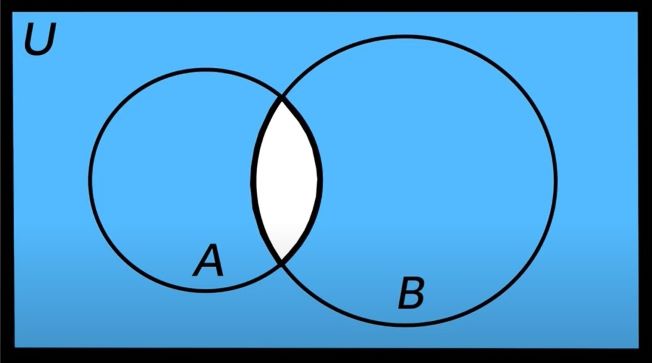
\((A\cap B)’=A’\cup B’\)
Let’s look at the next statement of De Morgan’s law. Consider the complement of \(A\) union \(B\). We know that \(A\cup B\) is everything in \(A\) with everything in \(B\), so the complement of this union is everything that’s outside of \(A\) and outside of \(B\).
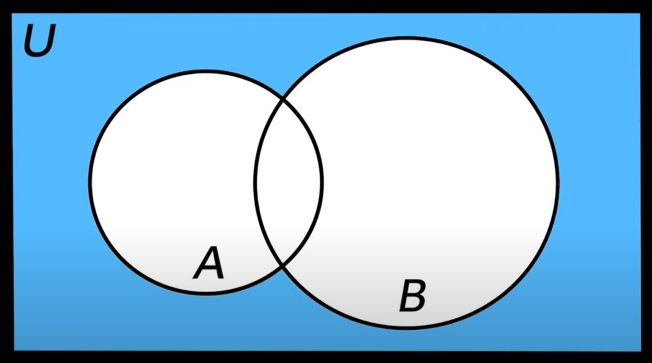
As with the previous statement of De Morgan’s law, we can rewrite \((A\cup B)’\) as “not” \(A\cup B\).
Then we can distribute the “not” by changing the union to an intersection.
So, the complement of \((A\cup B\) is equal to \(A’\cap B’\). Let’s check this with a Venn diagram. Once again, \(A’\) is everything outside of \(A\), and \(B’\) is everything outside of \(B\).
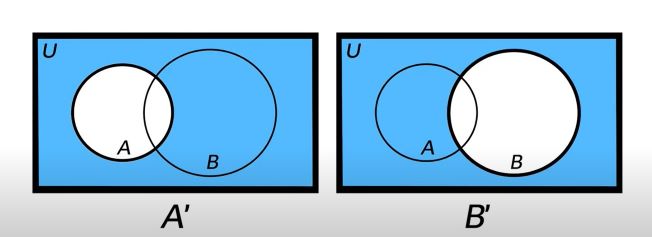
The intersection of these areas is only what is counted in both of them, which is the area completely outside of \(A\) and \(B\). As we said a moment ago, this area can also be called \((A\cup B)’\).
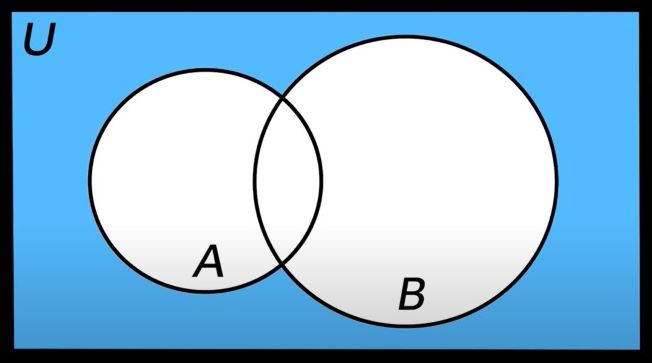
By this we have verified De Morgan’s law that the complement of \(A\cup B\) is equal to \(A’\cap B’\).
Let’s now apply this knowledge to a couple example problems.
What is another way to write the complement of \(A\cap B’\)?
This example is a little different because we now have \(B\)’s complement instead of \(B\). We can rewrite this using the same techniques as before. Let’s start by writing the word “not” instead of the complement symbol: Not \((A \cap B’)\). Now, De Morgan’s law says that we can distribute this “not” to the \(A\) and \(B’\) inside the parentheses IF we change the intersection to a union:
“Not \(B’\)” can be rewritten as simply \(B\), because the “not” and the complement cancel each other out.
Let’s finish by rewriting “Not \(A\)” as \(A’\).
This is as far as we can simplify this expression. So, the complement of \(A\cap B’\) is equal to \(A’\) union \(B\).
Let’s finish with a word problem. Rewrite the following statement using De Morgan’s laws: “It is not true that we are going to eat hamburgers or that we are not going to bake cookies.”
This statement is a bit confusing as it is currently written, but we have the tools to rewrite it in a clearer way. What can we already determine about this statement? Well, the phrase “it is not true that” indicates that the remainder of the sentence is to be negated. So, we can write this in a sort of set notation as the complement of (hamburgers or not cookies).
You’ll recall that the word “or” in set theory is associated with the union of two sets. Let’s write the union symbol in place of “or.”
Let’s now distribute the outer “not” to hamburgers and “not cookies,” remembering to switch the union to an intersection.
Here, the two nots before cookies form a double negative and cancel each other out, leaving us with:
So, if we say, “It is not true that we are going to eat hamburgers or that we are not going to bake cookies,” we mean that “we are not going to eat hamburgers and we are going to bake cookies.” A more natural way of saying this is, “we are not going to eat hamburgers, but we are going to bake cookies.” The word “but” can be used in place of the intersection’s “and” whenever one of the sets is negated.
As we have seen, De Morgan’s laws state that a complement can be distributed to the sets inside parentheses as long as the union inside is swapped for an intersection, or if it is an intersection, swap it for a union when distributing the complement.
Not \((A\cap B)\rightarrow \)Not \(A \text{ }\cap\) Not \( B\)
De Morgan’s laws are simple yet effective at turning complicated set theory expressions into more manageable ones.
Thanks for watching, and happy studying!
